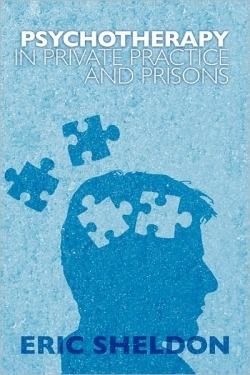Psychotherapy in Private Practice and Prisons
As a profession that largely takes place behind closed doors, psychotherapy is particularly dependent on the shared wisdom of its practitioners, and high-quality books by experienced therapists are always welcomed. In Psychotherapy in Private Practice and Prisons, Dr. Eric Sheldon seeks to provide mental health clinicians with information to help them develop well-rounded therapeutic strategies. He has written a thorough work with many strengths. His experience in prisons, for example, lends particular authority to areas such as client resistance to therapy. In addition, he offers useful instructions on how to ask questions effectively, and how to manage suicidality.
The book covers communication models, cognitive and behavioral techniques, stages of change, medication adherence, goal setting, and relapse prevention, and it offers multiple case examples. The author draws from many major psychological theorists, whom he cites effectively. There is an excellent bibliography and index.
Certain readers may find the text and layout to be overly dense and uninviting, and Sheldon utilizes an awkward format for abbreviations, e.g., T for treator, C for client, C1 for client as speaker, et cetera. This results in text such as, “When T look and act busy…when they use jargon that C does not understand, or when they cut off and interrupt C, they are projecting an image to which any P or C in his or her right mind will react negatively.” Eventually, such syntax becomes mind numbing, which is a shame because there is so much worthwhile material here.
The organization of the wide-ranging material is not always easy to understand. In the “Communication and Miscommunication” section, for example, “Building a Treatment Alliance” is followed by “Symptoms” followed by “Therapeutic Communication.” One senses that the author sees a logical progression there, but it isn’t easy for the reader to follow. So many topics are presented that it feels as if the author is valiantly trying to cram a lifetime of experience into this single text, which is impossible. Less would be more, in this case. Fortunately, the index can serve as a guiding light into the material.
Sheldon includes multiple examples of what not to do as a therapist; while some illustrations are useful, the technique is over-utilized. In addition, he uses the “Tying up Loose Ends” section, as a desultory grouping of matters that apparently didn’t fit in easily elsewhere in the text. If the section was better organized, it would improve accessibility and reader enjoyment.
Clearly evolved from Dr. Sheldon’s own substantial and diverse professional experience, the book will have value as a teaching tool and reference work.
Reviewed by
Laurie Sullivan
Disclosure: This article is not an endorsement, but a review. The publisher of this book provided free copies of the book and paid a small fee to have their book reviewed by a professional reviewer. Foreword Reviews and Clarion Reviews make no guarantee that the publisher will receive a positive review. Foreword Magazine, Inc. is disclosing this in accordance with the Federal Trade Commission’s 16 CFR, Part 255.

